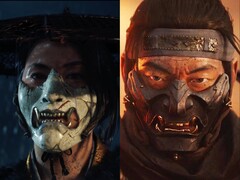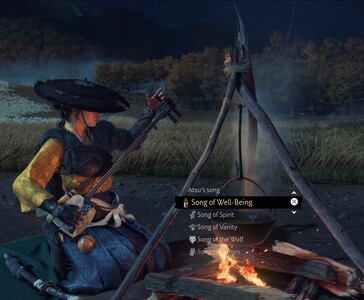Ghost of Yotei, Sucker Punch’s next open-world samurai title, builds on the foundation of Ghost of Tsushima but marks a clear shift in gameplay design. Set in Ezo, it follows Atsu, a lone mercenary on a path of revenge, and introduces new systems that change how players approach exploration, combat, and progression.
Atsu takes a different path from Jin Sakai. In Ghost of Yotei, players can disarm enemies, lose their own weapons mid-fight, and pick up gear from the battlefield. The combat system adds counters tied to enemy types and supports switching between five weapons, katana, odachi, dual swords, spear, and saragama, at any time. Considering most players will likely be familiar with the rest of the popular Japanese origin weapons, an odachi is a long, heavy sword used for sweeping strikes, while a saragama is a chained sickle designed for mid-range encounters attacks.
Exploration in Ghost of Yotei moves away from Tsushima’s region-unlocking approach and adopts a clue-based structure. Players uncover story leads by interrogating enemies or talking to NPCs, each pointing to regions inspired by Japanese folklore like the Kitsune or Oni. These areas offer distinct enemies, visuals, and skills. Progress is tracked using a card system, with new abilities unlocked by locating altars, often hinted at by golden birds or revealed through travel maps sold by cartographers.
Each branch of Ghost of Yotei’s five-part skill tree focuses on a distinct playstyle, Core boosts fundamentals, Melee enhances close combat, Enreo taps into supernatural powers, Revenge rewards aggressive momentum, and Wolf upgrades your companion abilities.
Although the game doesn’t delve fully into magic, Atsu’s supernatural abilities stem from her reputation as an Enreo, a vengeful spirit in local folklore. Feared by enemies and mythologised by the people of Ezo, her ghost-like powers are grounded more in legend, fear, and psychological warfare than in fantasy. Think Batman: Year One, but with a katana.
Moreover, Atsu’s wolf companion plays a more active role in combat and progression, with upgrades handled through the Wolf Pack menu, which also replaces the traditional quest journal. Players can slide, apply oil to weapons for elemental damage, and equip charms that scale with usage. Loadouts, armour variations, and power-graded charms allow for quicker switching between builds.
Players can now set up camp anywhere, turning it into a flexible hub for resting, cooking, and connecting with companions. Campsites also serve as upgrade stations where vendors, trainers, and allies can show up without needing to leave the region. Playing shamisen songs at camp reveals nearby hidden activities, including shrines and bamboo-cutting challenges.
Ranged combat also sees new additions beyond the short bow, longbow, and rifle. Atsu can also use kunai, bombs, blinding powder, and a matchlock pistol. Bombs and elemental oil buffs function similarly to Ghost’s Way of the Flame. Stealth mechanics, including chain assassinations and support tools, return with refinements.
Ghost of Yotei adds three new cinematic modes aimed at changing how the game feels, not just how it looks. Kurosawa Mode returns with its signature black-and-white filter, created in partnership with the late director’s estate. 13 Assassins Mode, developed with filmmaker Takashi Miike, introduces a closer combat camera and heavier blood and mud effects.
The standout, though, is Samurai Champloo Mode, featuring original lo-fi tracks curated by Samurai Champloo creator Shinichirō Watanabe, blending stylised combat with a genre-bending soundtrack. Ghost of Yotei launches October 2, 2025, for PlayStation 5. Available via Amazon (affiliate link). Pricing and PC availability have not yet been confirmed.






















